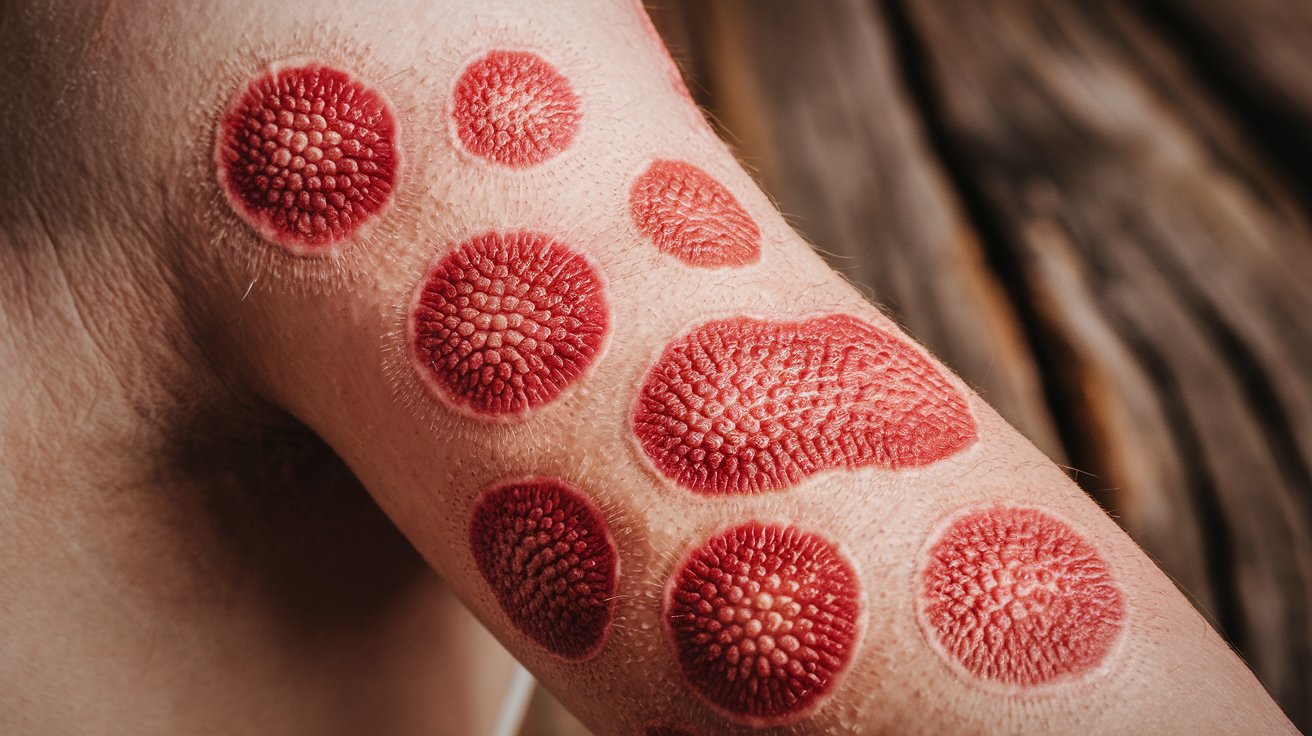
What are dermatophytids? Dermatophytids, also known as "id reactions," are allergic responses to fungal infections. These reactions don't occur at the site of the infection but rather in distant areas of the body. For example, if someone has athlete's foot, they might develop an itchy rash on their hands or arms. Why do they happen? The immune system reacts to the fungal infection, causing inflammation elsewhere. Are they contagious? No, dermatophytids themselves aren't contagious, but the underlying fungal infection can be. How are they treated? Treating the primary fungal infection usually resolves the dermatophytids. Why should you care? Understanding dermatophytids helps in managing symptoms and preventing misdiagnosis.
Key Takeaways:
- Dermatophytids are skin reactions caused by fungal infections elsewhere in the body. They can appear on different body parts and are often itchy and red.
- Prevent dermatophytids by maintaining good hygiene, avoiding sharing personal items, and strengthening your immune system through a healthy lifestyle.
What are Dermatophytids?
Dermatophytids, also known as "id reactions," are secondary skin eruptions that occur in response to a fungal infection elsewhere on the body. These reactions can be confusing and often lead to misdiagnosis. Let's dive into some fascinating facts about dermatophytids.
-
Dermatophytids are not caused by direct fungal infection but are a hypersensitivity reaction to a primary fungal infection.
-
These reactions can appear on parts of the body that are not directly infected by the fungus.
-
Common sites for dermatophytids include the hands, feet, and trunk.
-
Dermatophytids often manifest as itchy, red, and inflamed skin patches.
-
The term "id reaction" comes from the German word "id," meaning "idea" or "concept," reflecting the body's conceptual response to infection.
Causes and Triggers
Understanding what triggers dermatophytids can help in managing and preventing these reactions. Here are some key points about the causes and triggers.
-
Dermatophytids are commonly triggered by fungal infections like athlete's foot, ringworm, or jock itch.
-
The body's immune response to the fungal infection causes dermatophytids.
-
Stress and a weakened immune system can exacerbate dermatophytid reactions.
-
Dermatophytids can also be triggered by bacterial infections, although this is less common.
-
Certain medications, especially antibiotics, can sometimes trigger dermatophytid reactions.
Symptoms and Diagnosis
Recognizing the symptoms of dermatophytids is crucial for proper diagnosis and treatment. Here are some important facts about the symptoms and diagnosis process.
-
Dermatophytids typically present as symmetrical, red, and itchy skin lesions.
-
These lesions can sometimes form blisters or pustules.
-
Dermatophytids are often mistaken for eczema or allergic reactions due to their appearance.
-
A thorough medical history and examination are essential for accurate diagnosis.
-
Skin biopsy and fungal culture tests can help differentiate dermatophytids from other skin conditions.
Treatment and Management
Effective treatment and management of dermatophytids involve addressing both the primary fungal infection and the secondary skin reaction. Here are some key points about treatment and management.
-
Treating the primary fungal infection is the first step in managing dermatophytids.
-
Topical antifungal creams and oral antifungal medications are commonly used to treat the primary infection.
-
Corticosteroid creams can help reduce inflammation and itching associated with dermatophytids.
-
Antihistamines may be prescribed to alleviate itching and discomfort.
-
Keeping the affected skin clean and dry is crucial for preventing secondary infections.
Prevention Tips
Preventing dermatophytids involves taking steps to avoid fungal infections and managing existing conditions effectively. Here are some useful prevention tips.
-
Maintain good personal hygiene to reduce the risk of fungal infections.
-
Avoid sharing personal items like towels, shoes, and clothing to prevent the spread of fungi.
-
Wear breathable, moisture-wicking fabrics to keep the skin dry.
-
Regularly inspect your skin for signs of fungal infections and seek prompt treatment if needed.
-
Strengthen your immune system through a healthy diet, regular exercise, and adequate sleep.
Interesting Facts
Here are some intriguing facts about dermatophytids that you might not know.
-
Dermatophytids can sometimes resolve on their own once the primary infection is treated.
-
These reactions are more common in individuals with a history of atopic dermatitis or other allergic conditions.
-
Dermatophytids can occur at any age but are more frequently seen in adults.
-
The exact mechanism behind dermatophytid reactions is still not fully understood.
-
Dermatophytids can sometimes be triggered by non-fungal infections, such as bacterial or viral infections.
Myths and Misconceptions
There are several myths and misconceptions surrounding dermatophytids. Let's clear up some of these misunderstandings.
-
Myth: Dermatophytids are contagious. Fact: Dermatophytids themselves are not contagious, but the primary fungal infection can be.
-
Myth: Only people with poor hygiene get dermatophytids. Fact: Anyone can develop dermatophytids, regardless of hygiene practices.
-
Myth: Dermatophytids are a sign of a severe fungal infection. Fact: Dermatophytids can occur even with mild fungal infections.
-
Myth: Dermatophytids will go away without treatment. Fact: While some cases may resolve on their own, treatment is often necessary for relief.
-
Myth: Dermatophytids are a rare condition. Fact: Dermatophytids are relatively common, especially in individuals with fungal infections.
Research and Future Directions
Ongoing research continues to shed light on dermatophytids and their management. Here are some exciting developments in the field.
-
Researchers are exploring new antifungal treatments that may be more effective in preventing dermatophytids.
-
Studies are investigating the genetic factors that may predispose individuals to dermatophytid reactions.
-
Advances in immunology are helping scientists understand the immune response involved in dermatophytids.
-
New diagnostic tools are being developed to improve the accuracy of dermatophytid diagnosis.
-
Future research aims to develop targeted therapies that can specifically address dermatophytid reactions without affecting the primary infection.
Final Thoughts on Dermatophytids
Dermatophytids, also known as id reactions, are fascinating yet often misunderstood. These secondary skin eruptions occur in response to a primary fungal infection, usually on the feet or hands. They don't contain fungi themselves but are a reaction to the body's immune response. Recognizing dermatophytids can be tricky since they mimic other skin conditions like eczema or allergic reactions. Treatment focuses on addressing the primary fungal infection, which usually leads to the resolution of the dermatophytids. If you suspect you have dermatophytids, consult a healthcare professional for proper diagnosis and treatment. Understanding this condition can help you manage symptoms more effectively and prevent unnecessary worry. Stay informed, and you'll be better equipped to handle any skin issues that come your way.
Frequently Asked Questions
Was this page helpful?
Our commitment to delivering trustworthy and engaging content is at the heart of what we do. Each fact on our site is contributed by real users like you, bringing a wealth of diverse insights and information. To ensure the highest standards of accuracy and reliability, our dedicated editors meticulously review each submission. This process guarantees that the facts we share are not only fascinating but also credible. Trust in our commitment to quality and authenticity as you explore and learn with us.


